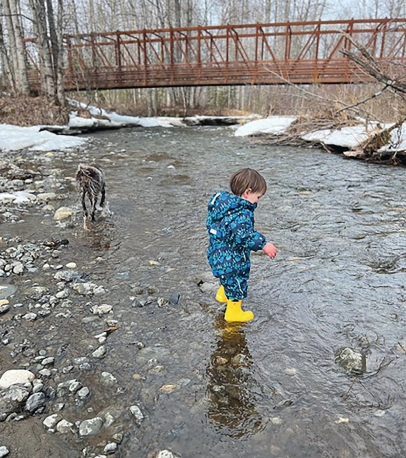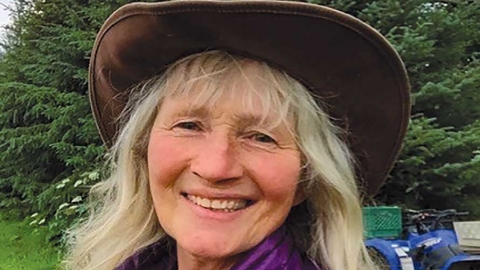Layered Listening
Trickling of melting snow. Wind brushing branches just beginning to peep green. Bright chip-chip of a foraging junco. Rushing creek swollen with glacial melt. And crunch, crunch of your footsteps on winter’s waning white blanket.
These sounds might be heard on a solitary morning walk along Campbell Creek, part of Alaska’s diverse systems of watersheds. A soundscape is all the sounds of a place in a given moment in time. Soundscapes of a watershed like Campbell Creek are layered and dynamic. Sounds come from high and low, near and far. Layers of sound may contain anthrophony, sounds made by people and human-made things; biophany, sounds made by other living things; and geophany, sounds made by Earth. And, sounds of a place change over time: moment to moment, hour to hour, day to day, season to season. These sounds offer a way of knowing and understanding a place. But, making sense of soundscapes takes attunement and intention.
Erin Marbarger, Senior Education Director and Director of Climate & Sustainability at the Anchorage Museum, is a good listener. She grew up in Colorado, in the arid West, where she was “connected to water,” as she says. She listened to the dynamic sounds of watersheds from valley to peak, season to season. Marbarger cultivated a sense of the importance of watersheds with them at the center of work and play. Her summers partly involved maintaining an irrigation ditch, Salvation Ditch, for ranch lands along the Roaring Fork Valley. This ditch moves waters from the local watershed to create irrigable lands for the valley. A ski patroller, Marbarger shepherded the waters high on the mountain in the form of snow that would later melt into those irrigation ditches. Water rights and access are unique in the Western United States, with convoluted histories of appropriation based on the idea that whoever was first to use water in a “beneficial” way has rights to it. This system is of course based on colonial settler ideas of benefit founded in economic gain.
Marbarger came to Alaska in 2013, and now manages a soundscape ecology program at the Anchorage Museum which utilizes soundscapes as the way to learn about and understand Alaska’s changing landscapes. The project encompasses a soundscape library holding thousands of hours of data from across the state as well as teaching and learning resources and programs for use in the museum and classroom, and at home.
Listening to the watersheds of Alaska means listening to the layered, dynamic sounds of life in this state. Alaska is home to 40 percent of U.S. water resources, over 2,000 rivers, and thousands of lakes. These systems fuel plants and animals, irrigate land now used for agriculture, and play a vital role in human culture and economy. The sounds of a watershed are not just the sounds of water itself, but the layered rhythms made by webs of life and networks of activity a watershed supports.
The sounds of a watershed are not just the sounds of water itself, but the layered rhythms made by webs of life and networks of activity a watershed supports.
As Marbarger says, in a watershed you might hear “the seasons change through the flow of the water; in spring, creeks will be louder and quieter in winter when there is less flow. In summer, creeks may be louder with swells caused by rain. You can hear evidence of all of this through the sound of the water… You might listen also to the animals that circulate in these areas, migratory waterfowl for example. Or, even the sounds of salmon running.”
Marbarger has lived, worked, and played along the watershed of Campbell Creek since coming to Alaska. Here, she has honed her listening season after season, building an attuned practice. In her teaching at the Anchorage Museum, Marbarger invites learners to develop their own practice with a simple exercise, a kind of “recipe” for close listening:
Take a moment to listen to Campbell Creek on April 16, 2019. What sounds do you hear? What sounds are familiar? What sounds can you not identify? What sounds are biophony, geophony, and anthrophony?
Through repeated listening to this same place over time, information that might not be visible to the eye or otherwise measurable may be revealed: hidden birds call, animals move through brush, waterflow varies due to weather changes at higher elevation. By listening year to year, the impact of climate change can also be heard in sounds like the timing of the first calls of migratory birds, or the sounds of higher or lower water levels.
Listening is also important in the kitchen. Next time you cook, take a moment to listen. What sounds do you hear? Perhaps the base layer of a humming fridge or sloshing dishwasher, low buzz of lights. Sound offers valuable queues to knowing and understanding our culinary experiences, and insight into our recipes. Like the soundscape of an outside location, the indoor soundscape of the kitchen changes with time of day and season: the quiet of early morning before boiling water for tea, the bustle before a gathering, the sudsy slowness of cleanup. Listening tells us not only about activity—human and otherwise (was that a mouse squeak?!)—but also the nature of the food we cook. Close your eyes when pouring—can you hear when your cup is full? The crackle of a bowl of cereal dulls as it becomes soggy. Oil sizzles just so when it is at just the right temperature for sliding in a salmon fillet. A chef with a keen ear can even hear when a spring green sorrel cake is done, if they listen closely.
By learning to listen inside and out, we understand the resonances of where we are, whether in the kitchen or in the watersheds of Alaska where we work, live, and play. As we listen again and again to the soundscapes of kitchens and creeks dear to us, we build a layered way of knowing where we are, our relationship to those locations, and how our activity impacts the places we love.











